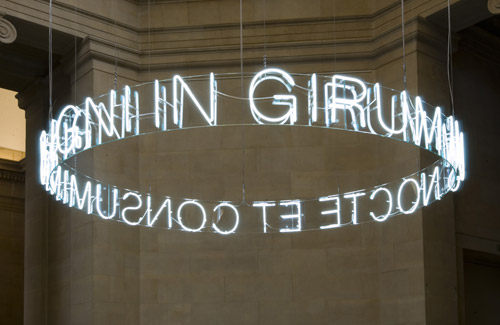

Cerith Wyn Evans: Situations…./(inste’leifen)
Ta Mo Chleamhnas Deanta (My Match It Is Made)
Ta mo chleamhnas deanta o athru areir
S'ni mo na go dtaithnioonn an bhean liom fein
Ach fagfaidh me i mo dhiaidh i
'gus imeoidh me liom fein
Ar fud na gcoillte craobhach
My match it was made here last night
To a girl I neither love nor like
But I'll take my own advice
And leave her behind
And go roaming the wild woods all over.
Shiuil mise thoir agus shiuil mise thiar.
Shiuil mise Corcaigh 'gus sraide Bh'l'ath Cliath
Ach samhail de mo chailin deas ni fhaca mise riamh.
'Si an bhean dubh a dhfhag mo chroi craite
I walked up and I walked down.
I walked Cork, and Dublin, and Belfast towns,
But no equal to my true love could I find.
She's the wee lass that's left my heart broken.
D'eirigh me ar maidin dha uair roimh an la
'gus fuair me litir o mo mhile ghra
Chuala me an smoilin 's an londubh a ra
Gur ealiagh mo ghra thar saile
I got up two hours before day
And I got a letter from my true love.
I heard the blackbird and linnet say
That my love had crossed the ocean.
Traditional, arranged by Van Morrison/Paddy Moloney from, Irish Heartbeat, Polydor, 1988
Cerith Wyn Evans, is an artist who intentionally moves against clear definitions. His art is at once intellectual, and spectacle. Previously, associated with experimental film and music, Wyn Evans has gradually creatively evolved to making, particularly light works fused with a host of new and archival technology which has allowed him to address varied and occasionally conflicting interests. Although his work is informed by his early training as a filmmaker, his work is less about the dynamics of film, in the sense of the works of, Steve McQueen, Douglas Gordon or Pierre Huyghe. It far more literary driven often evoking the work of varied figures from Kenneth Anger, Pier Paolo Pasolini to Ellis Wynne or Brion Gysin.
Wyn Evan’s installations and object have been described as simultaneously radical and complex. His work is characterized by need to express “ the clarity of a single conceptual idea that may take many forms, filtered through a highly refined aesthetic. Wyn Evan’s art cut across the divisions of means, cultures mediums, subjects, past and present.
Born in Llaneli, South Wales in 1958, Cerith Wyn Evans graduated from the Royal College of Art in l984. He began his career as a video and filmmaker working as an assistant to the filmmaker Derek Jarman. During the l980s, Wyn Evans shot experimental films that have been shown in Britain and abroad. He also collaborated with choreographer Michael Clark, Leigh Bowery, Trobing Gristle, The Smiths, and The Fall. Wyn Evans taught at the Architectural Association in London.
These varied disciplines act as points of departure for the artist as his work equally incorporates an astute comprehension of literature, philosophy, music, and photography. The major themes of Wyn Evan’s art are information, poetry, art, science, and communication. Literature is an essential element of his work, which greatly inform his language-based works. Often the reference texts reflect ideas related to art movements of the 20th century from Surrealism to Conceptualism. His work is guided by what has described as a “language of aesthetic” informed by Surrealism, Conceptual Art and the Situationist utopias of the l960-70s. It is art that intents to actively engage the viewer toward points and the “in- betweens”, where the possibility of new cultural identities can emerge, and where discourse both internal and external to art can co-exist.
Wyn Evans' works are loaded with socio-political complexities despite there somewhat the simplicity and elegance of the materials means. In the early 1990s, Wyn Evans began making sculptures and installations employing a variety of media such as neon, orchids, fireworks, which were wooden strips that spell out, open-ended texts that burn over a designated period of time. He equally used film, photography, and sculpture to explore his ideas of perception and conceptual limits. Many of these early sculptural works took the form of chandeliers which contained texts that referenced late 20th century poetry, but equally borrowed from letters, short stories and philosophy. These texts are often transmitted through Morse –code enacted by pulsing light bulbs. However, Wyn Evans has been noted that his work is often a departure from text.
These works highlight language in the form of different kinds of encoded statements while simultaneously suggesting elusive, fluctuating boundaries of a private, social or fantasized condition. These chandelier sculptures are often made to evoke an otherworldly language from sections of text translated into the flashing light signals. Reflections and dazzling light effects induce a loss of bearing, pulling the viewer into what has been characterized as “ a de-stabilizing experience”. The transmission of Morse signals supplied by a computer of which we see only the screen on which the text transmitted slowly appears are physically and intellectually linked to the actual object. The inherent meaning of text becomes the focus of interpretation and less the chandeliers mechanically pulsing light. The eloquence of many of his chandeliers are subversive, in that the related text are often theoretical, political, and highly charged point of re-considerations. They are objects for discourse as opposed to tangible bourgeois cultural artifacts.
Given his formative background it is not surprising that the artist is equally interested in sound, particularly music soundtracks, and the manner sound in which sound can provide a parallel narrative to films or photographs. In this context what drives the artist is the re-reading of the visual once the sound is dislodged, altered, or removed.
His early works are dealt with the phenomenology of time, and perception. Wyn Evan’s first solo exhibition held at White Cube, London in l996, involved an installation entitled: Inverse, Reverse, Perverse consisting of a large concave mirror, that invested and radically distorted the viewer’s reflection, producing a disturbing self portrait and altered perception of self and place.
Since that period Wyn Evans had exhibited extensively in Europe including the Hayward Gallery, London, British School at Rome, but he is has less exhibited here in the U.S., although the artist has created major projects at MIT; Berkeley Art Museum; MFA, Boston, and Deitch Project, New York; where along with one of his concave mirror works, he installed, a text pieces inscribed in fireworks “I take my desires for realities because I believe in the reality of my desires”. More recently Wyn Evans has presented solo projects at Kunsthaus Glarus, Switzerland, and Georg Kaargi, Vienna, Kunstverein, Frankfurt, the Tate Britain Now Series, and the 50th Venice Biennale.
Wyn Evans has also created a series of public interventions. For the Biennale, the artist beamed a light into the night sky that signaled a Morse Code translation of a text by Ellis Wynne (1671-1734), a founder of Wales literature tradition, and whose Gweledigae theu y Bardd Cwsc (Vision of the Sleeping Bard) published in 1703 is considered a Welsh classic. A computer in the inaugural Welsh Pavilion displayed the text. The artist has also created a series of two signs at the top of London’s Centre Point Tower viewer by any passer-by. The signs have been altered by the artist to transmit an extract from The Visible and Invisible by the philosopher Maurice Merleau –Ponty by Morse code. During the evenings “Mean...across town” (as the work was titled) could be seen from Hempstead. Wyn Evans intervention used a blinking “O” (facing West) and “I” (facing East) to transmit the text for about an hour each evening.
Wyn Evans has said of the project that “ For me there is a certain paradox and conceit about harnessing this location, it’s like high-jacketing an icon…” As the two letters blink on and off, the sign facing East intermittently read as ‘ Centre Po nt” suggesting a bridge; facing West, the signs reads as “ Centre P int” a play on the words and a reference to Wyn Evans encounter with the building some years ago as he walked down Oxford Street with a friend and, noticing the sign with a faculty “o”, they retired immediately to the pub. The Merleau-Ponty text was displayed discreetly in a number of ways and locations in and around the Centre Point area letting words; connections and ideas intertwine into the urban and social environment of the London’s West End area.
His work is best understood through his multifaceted installations as opposed to singular work. Recent projects in Boston, Paris, and London have given us the opportunity to experience the work in all its diversity. These include major exhibitions of the artist’s work mounted at the Musee d’Art Moderne de la Ville de Paris/ARC, Paris and ICA, London.
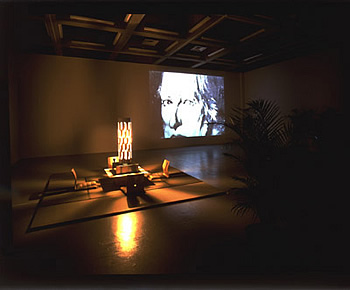
At MIT List Visual Arts Center, Cambridge /Museum of Fine Arts/ Boston: “Thoughts unsaid, now forgotten…”
For the combined projects at LIST and the MFA, Boston, Cerith Wyn Evans, combined past works as well as series of archival items out of the List’s science museum and exhibited them as type of “found “ objects. The sculptural installation continues Wyn Evans investigation into the aesthetics concepts have between scientific and artistic vision. The installation becomes a site-specific project exploring the relationship between image and word, poetry and science, divination and earthy communication, and spoken and written language.
The exhibition consisted of several installation components. A single black chandelier was shown at LIST with the artist concentrating “found” obsolete technological objects from the MIT Museum collection as “ready-mades”. Upon entering the gallery, the viewer is greeted by her/her own reflections through a convex mirror sculpture. The installation, also include the work “The Slide Rule Man”, (2004) an audio recording from the sixties (1961) of an engraver who traveled between science schools inscribing students’ names on their slide rules. Three Asian scholar ‘s rocks borrowed from the MFA were displayed in proximity to the audio piece. Cerith Wyn Evans had essentially transformed the Asian scholar rocks without any clear intent why moving them made any difference. The artist’s intent is to talk to the hybridity between nature and art.
The project contained the sculpture “Thoughts, unsaid, now forgotten”(2004), a reversed text neon work. The work faced a large plate glass window into a well-traveled courtyard. The sharp, bright neon image reflected off the glass even in daylight, such that from the inside the reflected text appears readable.
The aforementioned single chandelier sculpture is “IMAGE (Rabbit’s Moon) by Raymond Williams” (2004) made of a black Venetian-glass, which spells out in Morse Code a text by Raymond Williams defining the word “image” from his seminal text “Keywords: A Vocabulary of Culture and Society” The sculpture is connected to a computer monitor that translates the Morse Code back into the texts.
Another component is “The Sky is thin as paper here…” (2004), a two slide-projections piece using a special dissolve unit, cast layers of black and white astronomical images with historical pictures of celebrations from traditional Japanese festivals. “The sky is thin as paper here…” (2004) was previously exhibited on tall mirrored pedestals, showing superimposed, nearly unreadable, black- and – white images of Japanese ritual celebration. ” “The Sky is Thin as Paper Here”, title is taken from Williams Burrough’s “The Place of Dead Roads”. Wyn Evans’ mixture of astronomy photos with of image of naked men performing Japanese religious rituals in a series of cross-fade slide show images overlapping, and at point dissolved their own intelligibility. Here the seemingly unrelated images produce a re-reading of the accumulated images.
Finally, Wyn Evans has included, a work entitled “WMBR Radio Station”, consisting of the actual wood-panel studio form MIT’s student run radio station. Wyn Evans took the original wood-paneled broadcast base from the studio and re-installed in a corner of the Gallery. The five elements of the station pay tribute to past technologies and the time before the Internet when the radio was an important tool for communication. MIT’s radio station was, and continues to be an inventive, using the latest technology to encourage free expression. MIT has used the station as a platform to consider punk, disco, and reggae in the l970s.
.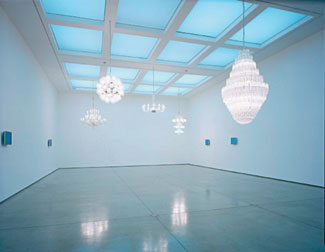
At the Museum of Fine Art, seven crystal chandeliers illuminate the galleries, each periodically flashing Morse code versions of a series of texts. The central work is “Chandeliers” (2004). The works were installed to appear as if they “found fixtures” ranging from a Conran mirrored disco ball to an elaborate Venetian construction, hung in a large empty gallery in the museum. Near each chandelier was a wall-mounted computer that slowly translated text. The original words and Morse code translations are displayed on computer screens set into the gallery walls.
Textural meanings are here meant to evoke cultural and artistic significance. Wyn Evans continues to reference sources which range from film, and literature to philosophy, creating what the artist has described as a “Catalyst or reservoir of possible meanings, which for the viewer could unravel many discursive journeys…” He leaves the viewer to interpret and experience the work on his /her own terms.
At the MFA Wyn Evans re-installs a text-firework based work.” Thoughts unsaid…then forgotten…just another elapsure of time (designated)”, whose text is actually mixing of quotes by Bas Jan Ader and Lawrence Weiner.
At White Cube/ London:
“The Curves of the Needle”
The project consist of a complex image-sound installation which was actually developed during a visit to Mexico City, where the artist was invited to make a work inspired by the house and museum of the modernist minimalist architect Luis Barragan at the Casa Barragan. Barragan was one of the most influential architects of the 20th century. His use of space and light in his buildings ushered in a new generation of late modernism that is still being interpreted architects.
Casa Barragan is an amazing combination of austere monasticism with its open-plan interior. The house remains in its original state, and loaded with material artifacts from the architect’s life. The very concept of site as point of invocation and communication has long fascinated Wyn Evans, and he uses Barragan amazing physical legacy as a point of departure.
Wyn Evans was interested in relaying how the relics of Barragan’s life, create a correspondence or a kind of friction between what is perceived as real life and what is constructed as memory, fantasy and projection.
The title of the installation is based on an essay by Theodor Adorno written in l927 and subsequently amended in l965 that examines the narration as a psycho-cultural portrait of the listener. This elliptical essay by the Frankfurt school German sociologist, philosopher, musicologist, and composer was intended to remind us of the intermediate connection between music itself and the technology use to distribute the music. The essay proposes that what the gramophone listener actually wants to hear is the prime records as virtual photograph of their owners, flattering photographs- ideologies.
Using two slide machines and a dissolve unit, Wyn Evans compiled an encyclopaedia of images ranging from motifs of architecture, elements of the surrounding city, images from elsewhere all of which are syncopated to arranged musical scores taken from Barragan’s enormous music collection in their original vinyl state. The images slowly dissolve into each other to create a type of psycho-geography/biography. The result is a fantastic connection of images that shifts between the vista and the detail, and the past and present.
Wyn Evans was drawn to the sonic possibilities of the architecture after observing that Barragan installed players in almost every room of his house. The artists organized a selection of tracks to be played on an assortment of turntables, which resembled a kind of technological timeline of the architect’s life dating from primitive to a 1970s Danish sound system. Wyn Evans then recorded the results keeping the ambient sound background so that the resultant soundtrack acts as field recording within the architecture. For Wyn Evans the process of selection and playing records became what has been described as “ another kind of technological archive mapped onto already very specific, architecture”. Parallel to his investigation of the record collection, the artist took various photographs while exploring the house, as such the project equally became about the reclamation of what has been termed “ the photographed “ interstitial spaces of the building and of the sound archive of (recently) un-played records.
The project at White Cube also include the installation, “Look at that picture...How does it appear to you now/ does it seem to be Persisting?”
This project differs, but appears to relate an earlier exhibition at White Cube, where Wyn Evans attached a white neon sign on the façade of White Cube, which reads “ slow fade to black”. “Looking at that picture…/How does it appear to you now?/Does it seems to be /Persisting?” included a series of five crystal chandeliers hanging together in the main gallery space. Michael Archer has noted that their stylistic differences produces a host of references to the contemporary city, both in its cosmopolitan reality and in the degree to which its forms embody modernity’s faded, thwarted, and displaced dreams and ideals. One of the chandelier design originated in an exhibition in Victor Horta’s Palais de Beaux-Arts in Brussels, another has been used in a Riyadh casino, a third by Achille Castigilione, lit a lounge at the Milan airport. Broodthaer’s “Décor” inspired the works.
There is a dialogue undergoing between the various sculptural works. Each chandelier presented in a different position, connected to a wall mounted plasma screen on which a text slowly appeared as it is converted from Morse code by a hidden computer. The process of translation controlled the turning on and off of light fixtures so that there is a constant flickering, as well as combination of short and long light pulse sounds throughout the gallery space.
One of the chandelier’s texts relates to the work of Brion Gysin interviewing English writer Terry Wilson on the subject of Eileen Garrett, a spiritualist medium who also worked for the CIA. Another concerns Theodor Adorno discussing astrology as “ the split between irrationality of the dream and rationality of the waking state”. Eve Kosofsky Sedgwick’s critique of J.L. Austin’s theory of performative speech is intended to relate to host of events is also presented here in one of the sculptural works. Still another chandelier construction cites John Cage multi-vocal style, in which the writer/musician asserts “two people making the same kind of music is one music too many. The gathering of Madame de Lafayette’s Princesse de Cleves (1678) writings are presented on one of the chandelier, while the actual texts were collectively produced by members of her salon. For Wyn Evans the text is symbolic of both the individual and collective imagination.
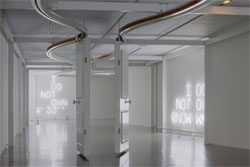
Musee d’ art Moderne de la Ville de Paris/ ARC, Paris:
“in which something happens all over again for the very first time”
ARC’s project represents the first retrospective of the artist’s work in France. In the exhibition organized by curators Laurence Bosse, Anne Dressen, Hans Ulrich Obrist, and Angeline Scherf in collaboration with the Stadtische Galerie im Lenbachhaus und Kunstbau, Munich. Situated over a series of galleries, its is installed in the wonderful minimal austere raised arced white high-ceiling space of ARC, a type of imperfect circle endowing the entire the exhibition with other-worldly quality. Architecturally the space reinforced the centrifugal movement of the chandlers and various elements in the exhibition. The exhibition project is placed in juxtaposition to the equally intelligent installation of Dan Flavin’s first major retrospective in France. The curators have noted that the concurrent exhibitions provides, “ a coincidence “ that sets up sympathetic vibrations between two distinctive oeuvres, both of which invite the viewer to experience light as a language. Flavin had stated art is a thought and not an act seems appropriate logic for understanding the art of Cerith Wyn Evans. It by thinking differently that artists influence our perceptions as such the works by both artists become signs of that thought process.
The projects/objects in the Wyn Evans exhibition included a range for work from as early as the l996, “The Inverse, Reverse, Perverse”, to “ The Sky Is Thin as Paper Here,” There is also the more recent, “Something like a Picture for Ali “(2006) consisting of Tropical plants (Tilandsia,) with electrical components. “The Portraits of Greatness Penetrated”, 2006 consist of a selection of framed print images from the book “Portraits of Greatness” (1959) by Canadian photographer Yosuf Karsh, a series of black and white celebrity portraits, including, Audrey Hepburn, Eleanor Roosevelt, Hemingway, Pie XII, in prayer, Albert Einstein, Magpie XIII. Wyn Evans has cleverly disfigures with perforations. Each of the portraits has an accompanying biographical text. Collectively, ninety-two individuals are introduced by texts. On the back of each picture is a text referring to someone else. These mis-readings results because Wyn Evans has instructed the curators to alter the arrangement of the montage through the show’s duration in order to unsettled the references, thus blocking out access to the biographies of the figures.
The exhibition begins with “Inverse, Reverse, Perverse”, 1996, a concave mirror offering a manipulated modified self portrait of the viewer, essentially flipping the spectators image upside down hanging at one entrance to the gallery. The title of the work refers to “The Gift” by the Velvet Underground. It is followed by white wall intentionally left blank, such that the mirrors set the viewer up for the series of texts, lights, sounds, and projected image that wonderfully emerges in this highly imaginative exhibition.
“In girum imus nocte et consumminur ign”, 2006. (We turn aimlessly in the night, consumed by fire) is a circular neon crown-like structure hanging from the ceiling whose Latin palindrome is that of Guy Debord.s last film, and reads, “ We enter the circle at night and we are consumed by fire”. Installed opposite “Inverse, Reverse, Perverse,” it is reflected in the set of mirrors, echoing the exhibition’s title, which is actually a neon work on show placed on the exterior of the museum’s façade. On the exterior of the museum in hidden terrace a white neon sign, reads: “ in which something happens all over again for the very first time” (2006) offers a parallel view of the Eiffel Tower visible over the rooftops surrounding the museum.
The central room is devoted to the painter and writer Brion Gysin (1916-1986), consisting of various elements and houseplants. A portrait of Gysin with his eyes closed is captioned with a neon sign that reads:” Brion Gysin, Mistra, near Sparta in Greece, 1938”. In addition there a series of drawings borrowed from the museum’s collection of the artist’s holdings on paper. Here, Wyn Evans also presents three of his re-constructions of Gysin’s “Dreamachine”. Wyn Evans has combined three of his dreamachines, Dreamachine (III), (IV) et (V), 2006 with the selection of drawings by Brion Gysim. Wyn Evans reasserts his link with the sixties cult figure.
Invented by Gysin and mathematician Ian Sommerville in the late l950s, these machines were thought of as the first sculptures to be looked at with your eyes closed through the transmission of light pulses to the brain, inducing a state of quasi-hypnosis. These cylindrical light shades spinning on wooden platform at 75rpm.when looked at with closed eyes were intended to evoke an notion altered consciousness, brought about by the rotating, flickering, light.
In the same space, Wyn Evans had invited Florain Hecker to create the sound work, consisting of a four - channel composition, realized win collaboration with Thyssen Bornemisza Art, Vienna, “Asynchronous Jitter, Selective Hearing”, 2006. The work point of departure is based on experiments of Denis Gabor, Iannis Xenakis, and Curtis Roads. The sound work is broadcast through 15 loudspeakers hung at different heights, the result causing spatial and sound fragmentation. The soundtrack is essentially a series of humming, screeching and squealing sound piece, resonating throughout the gallery.
In the physical curve of the museum’s architectural space, Morse code light pulses from l7 glass chandeliers reflecting the skill of glassmaking of Murano, all different, and each designed by a leading designer. They consist of sparkling candelabras, reflective balls, and ornate tendrils. Each hang throughout the exhibition space suspended from the ceiling at different heights. Their bulbs blinked out words and signs in the Morse code connected to screens of computers where fragments of texts chosen by the artist are translated into Morse. The codes are gradually revealed as phrases that appear on plasma screens opposite each chandelier.
The extracts are overlaid like a polyphonic “collage”. All genres of literature are extracted here: including letters, poems, short stories, interviews, science fiction, scientific articles, philosophy and linguistics. The subject matter embrace futurist imaginings, scientific and musical explorations, and esoteric languages, all of which points to the circuitous paths to experience and knowledge.
Collectively the texts are derived from the Wyn Evans’ personal pantheon, which scroll down on various computer screens. They are taken with the exception of “The Princess of Cleves”, from the literature of the last thirty years.
Among the sources for the chandeliers cryptic texts are James Graham “Ballard Myths of the near future”, “Brian Gysin, interviewed by Terry Wilson” John Cage’s “X; Writings 79-82”, Guman, “Photographic Calibration of Sunspot Equidensitograms”, Marta Weiner “ Emily Dickinson’s Open Folios: Scenes of Reading, Surfaces of Writing”, Madame de Lafayette, “La Princesse de Cleves”, Eve K. Sedgwick, “Touching Feeling Affect Pedagogy”, Lina Bo Bardi catalogue from Museu de Arts de Sao Paulo-Sao Paulo 1957-1968, Iannis Xenakis “Lettre a Hermann Scherchen”, Mitsou Ronat “The Glorious Body of Laure”:, Michel de Certeau , “L’invention du quotiden”, Judith Butler, “Gender Trouble: Feminism and the Subversion of Identity”, Ian Sommerville, “Flickers of the Dreamachine”, Tokio Oga & Koichi Mimura, “Bunraku”, James Merrill, “The Changing Light at Standover”, “Fiflth an S.T. H. Chap-Book ,True Homosexual Experiences from S.T. H. Writers”, and Pierre Kloosowski, “La Monnaie vivante”.
There is also a curious “ aquarium” piece, “Something like a picture for Ali,” 2009, in which tropical plants generate light –producing acid.
.
At ICA, London:
“Take my eyes and through them see you
Jens Hoffman and Rob Bowman organized Cerith Wyn Evans first major solo exhibition in a UK institution,” Take my eyes and through them see you. For the project Wyn Evans continues his tendency to avoid repetition. Having successfully presented a type of “overview” at ARC, Paris, here the artist changes directions. Wyn Evans has made this a characteristic aspect of his practice in his work that occurs explains as means to avoid categorization. With the exception of the work, “Magpie” the e installation is devoid of objects, and text.
For The ICA, Wyn Evans has created a body of works in direct response to the history, location, and architectural specifics of the building. The project has been described an opportunity for the artist to consider his personal relation with The ICA, which has been instrumental in his development. As an artist, Wyn Evans’s personal interaction with ICA, extends from his inclusion in The ICA exhibition entitled, “A Certain Sensibility” a month long series of Super 8 film screenings as part of its then newly opened Cinematheque in 1979. However, the artist first visited The ICA as a teen in the early 1970s where he viewed the work of Marcel Broodthaers’ final project which included plants, and garden furniture and his film, “La Bataile de Waterloo” (The Battle of Waterloo), 1975. Broodthaers’ installation also included two antique cannons aimed toward Whitehall, and the Mall. The cannons were installed pointing at prime targets; Downing Street and Buckingham Palace, as such Broodthaers symbolically address issue of the politics of power and culture. The exhibition’s overt political content has an enormous effect on Wyn Evans and become the point of entry for the new works Wyn Evans creates for ICA.
At The ICA, Wyn Evans has created a series of subtle observations focusing on the dynamics of the relationship of the institution, the art it exhibits, and the world outside the ICA. Situated on the mall, not far from Buckingham Palace and overlooking Horseguard’s Parade and Downing Street The ICA has long had a complex relationship with its surroundings. In the l970s MPS attempted to close the institution for exhibiting what is deemed as “obscene art”. Similar to the work of Broodthaers’ earlier installation, Wyn Evans has used its location to critique ideas about art, power and control.
At The ICA, Wyn Evan has created “Décor” (2006) in which the artist has taken down the ground floor gallery space and dismantled the wall onto the Mall. Removing the false walls covering the windows so that daylight floods into once contained/controlled space, the artist metaphorically and physically opens up the building in doing so re-create a symbolic dialogue with those force of bureaucratic power and authority. Wyn Evans has essentially re-opened this complex history, raising questions of exclusion and inclusion, visibility and the hidden. The viewer is left to consider the impact of the architectural space as point of conjecture about artworks and politics.
In a early discussion of the project for ICA, Wyn Evans states: “It’s about doing less than as little as possible, which is quite hard to do…. There‘s quite a lot of work to do in terms of doing something that is really reductive in that kind of way”.
It has been suggested that Wyn Evans artistic strategies which have often played with a type of subversive eroticism is translated here by the act of removing the layers of the architectural confound is in sense eroticizing the building itself.
Interviewed in a recent article in ArtReview, Wyn Evans states that “…The Mall that corridor of power is going to be partially stripped and exposed by gay Welshman and that something of that action will be always be on show (It’s change the way people appreciate the space at the ICA, he says, because they’ know what it used to look like, and now it looks a little different”.
(“The Thrill and Hurting; The Horny and Homicidal World of Cerith Wyn Evans”, ArtReview (no3.) September, 2006 pp. 71-3)
In the installation Wyn Evans also manage to pays homage to Broodthaers through the inclusion of series of potted palms. They are meant to reference Marcel Broodthaers’ “Wintergarden”. However the foliage symbolism is also reminiscent of the palm plant installations which was used in the Paris exhibition to paid homage to Brion Gysin.
In another room, the installation “title withheld” (2006) consist of Venetian blinds that open and close that in the process create a flashing Morse code message. As the blinds, the gallery lightens and dim, the message, which also appears on a screen, doesn’t appear to bear any discernible relationship to its setting.
In the next room, has installed the project titled work, a looped black film composite piece“ Take my eyes and see through them…”. In the installation an old 35mm projector beams a blank film. As the movie continues the celluloid gradually deteriorates, revealing numerous starches began to ‘scribble” message in light on the screen. Simultaneously a white film is gathering dust that projects as an accumulation of black squiggles. Wyn Evans, continues his exploration of how soundtracks (in this case the lack of) can provide a parallel narrative to film. There is a subtle ritualistic quality to the work, which invites comparison to Derek Jarman’s “The Last of England.
In between the two rooms a neon message reads” And if I don’t meet you no more in this world then I’ll meet you in the next one. And don’t be late”. The front of the letters of each word has been painted black so that the sign has to be read obliquely.
In an upper wall, Wyn Evans has included the delightful, “Please pay attention motherfucker” a stuffed magpie perched on a branch sticking out of the wall.
Viewed collectively Cerith Wyn Evans’ work, points of connections is never static. Ann Wilson Lloyd has offered that Wyn Evans’s art is representative of a conflicted sensibility, neutralizing easy spectacle and nostalgia with obfuscating conceptual ploys. Wynn Evans wants the viewer to consider how language/literature operates as analogical, indexical, conventional, and finally natural. Wyn Evans positions in many of these works are less specific, he intentionally is evasive for the works are never melancholic, never are they neutral rather they are meant to be didactic and discursive. Cerith Wyn Evan’s fuse of a multiplicity of texts source often in single work keeps his intentions open-ended and in flux. It is the very point where the disjunctive between sign and meaning dissolve that Wyn Evans wants to interject the viewer position.
His installations are what the activated by what spectator can actually discern, it is his/her outlook that far more of concern for Wyn Evans and less about the physicality of the objecthood.
“It is the spectator and not the life that art really mirrors”
Oscar Wilde
They point to inward and outward points of entry for the spectator, both the allusive and the provocative. Wyn Evans has continually proven he not afraid to tackle more radical subject matter, evident in the 16mmm film of l988 “Firework Text (Pasolini)”. Pasolini’s life’ was one filled with contradictions, a devout Marxist, he was expelled from the Communist Party for his homosexuality which the party had equated as “ ruinous aspects of bourgeois society”. Both anti-clerical and politically radical, Pasolini worked with many of the seminal figure of Italian cinema including Fellini, and Bertolucci. His cinema classics include “Terorema” and “Mamma Roma”. In l975 Pasolini was found bludgeoned to death in the seaside outskirts of Rome.
For the work, near the site of Pasolini’s death which is has been placed a marker, Wyn Evans constructed a temporary sign made from wood and fireworks .The firework text -imagery paraphrases Pasolini’s “Oedipus Rex”, which described willow trees along the river of his hometown. In Wyn Evans’ film lines of the text appear and disappears against a deep blue sky. Wyn Evans has intentionally left the narrative open-ended echoing Pasolini’s film structure.
Cerith Wyn Evans installations are a complexity of interlocking self-contained works. They are meant to questions the very nature of communication and the nature of the cultural and political knowledge. They are less about their objecthood as they are about the void that speak to impulse, the unpredictable, shifting responses, implied sensibilities. These installation range from the quiet allusive meditative occurrences to pulsating, assertive installations of light and computer technology. But they are essentially grounded in a dialogue of memory, religion, science, art and the vary issue of media itself.
@Horace Brockington, 2007
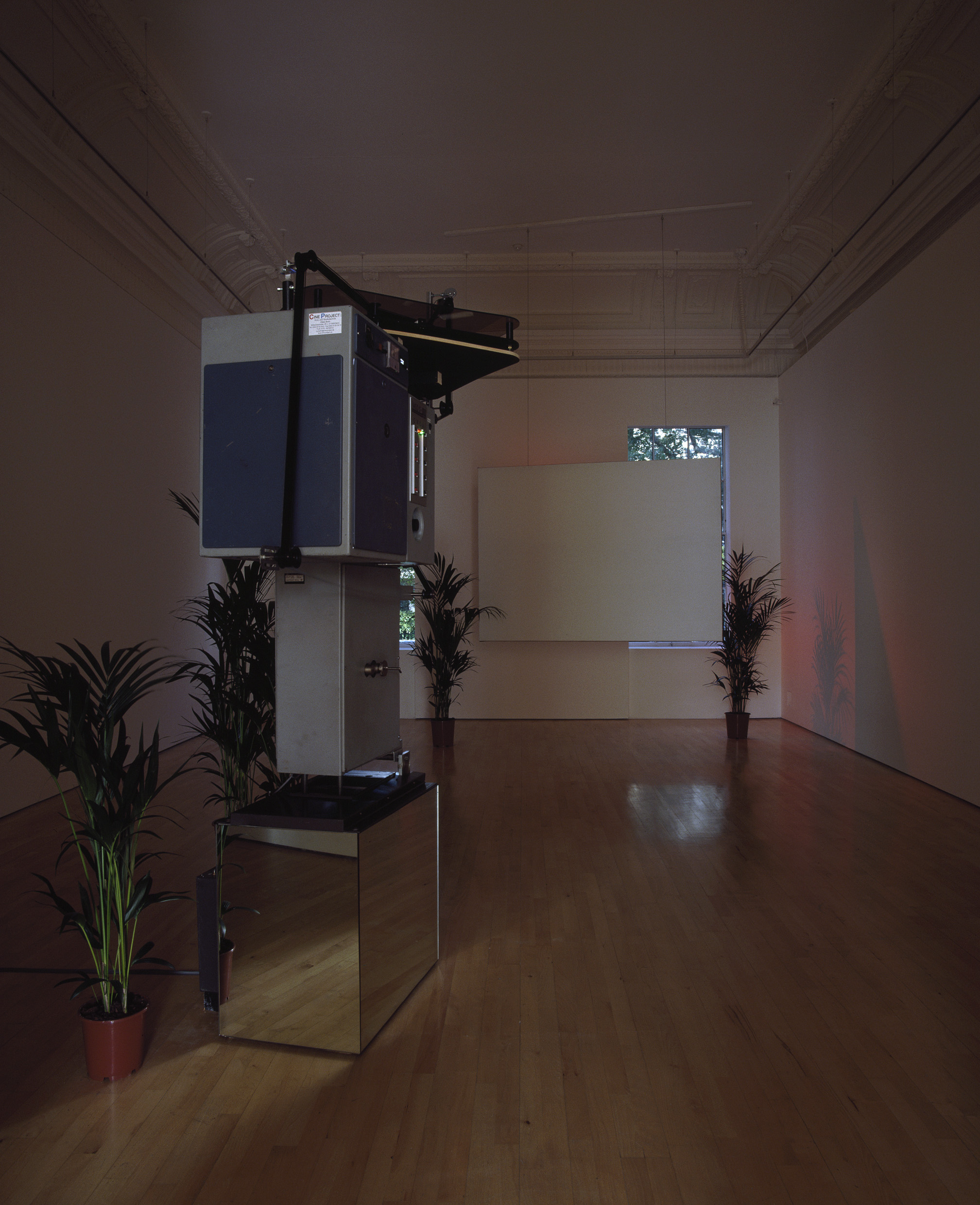
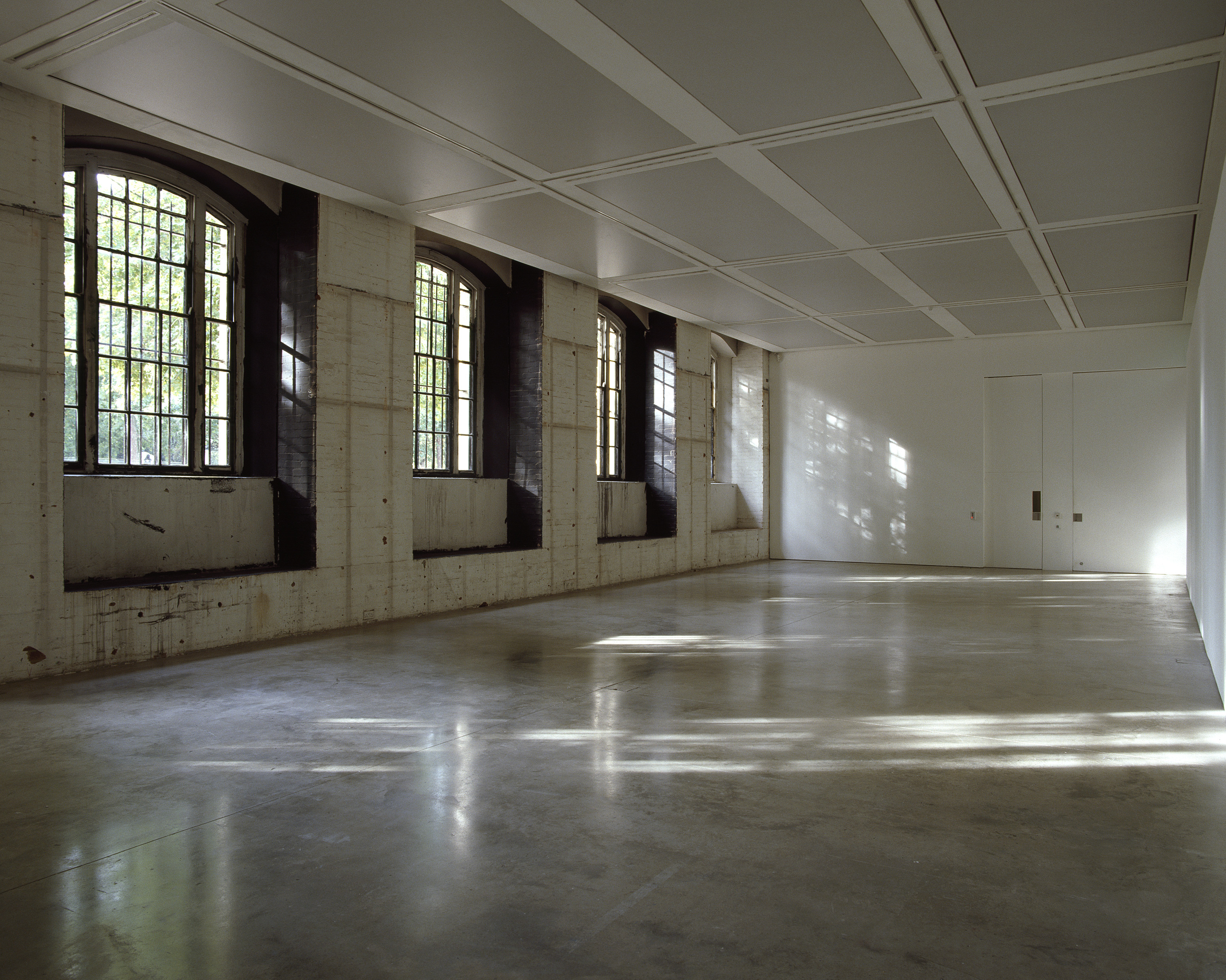
London
02: Please pay attention motherfucker, from take my eyes and through them see you, 2006, Stuffed Magpie, Dimensions variable Courtesy of the artist and the ICA, @Marcus Leith
03: Décor-Detail (2006) from take my eyes and through them see you, 2006 1880cn long and 430 cm high, Courtesy of the artist and ICA @ Marcus Leith
08: title withheld (2006), from take my eyes and through them see you, 2006, Venetian blinds, flat screen monitor, Morse code unit, computer, Dimension variable, Courtesy of the artist and the ICA, @ Marcus Leith
09:takes my eyes and through them see you, from take my eyes and through them see you, 2006, 35mm film, 4 mins. Looped, Courtesy of the artist and the ICA, @ Marcus Leith